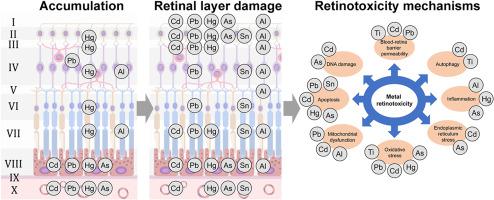当前位置:
X-MOL 学术
›
Food Chem. Toxicol.
›
论文详情
Our official English website, www.x-mol.net, welcomes your feedback! (Note: you will need to create a separate account there.)
Retinal toxicity of heavy metals and its involvement in retinal pathology
Food and Chemical Toxicology ( IF 4.3 ) Pub Date : 2024-04-23 , DOI: 10.1016/j.fct.2024.114685 Michael Aschner , Anatoly V. Skalny , Monica M.B. Paoliello , Margarita N. Tinkova , Airton C. Martins , Abel Santamaria , Eunsook Lee , Joao B.T. Rocha , Sandra H.P. Farsky , Alexey A. Tinkov
Food and Chemical Toxicology ( IF 4.3 ) Pub Date : 2024-04-23 , DOI: 10.1016/j.fct.2024.114685 Michael Aschner , Anatoly V. Skalny , Monica M.B. Paoliello , Margarita N. Tinkova , Airton C. Martins , Abel Santamaria , Eunsook Lee , Joao B.T. Rocha , Sandra H.P. Farsky , Alexey A. Tinkov

|
The objective of the present review is to discuss epidemiological evidence demonstrating the association between toxic metal (Cd, Pb, Hg, As, Sn, Ti, Tl) exposure and retinal pathology, along with the potential underlying molecular mechanisms. Epidemiological studies demonstrate that Cd, and to a lesser extent Pb exposure, are associated with age-related macular degeneration (AMD), while the existing evidence on the levels of these metals in patients with diabetic retinopathy is scarce. Epidemiological data on the association between other toxic metals and metalloids including mercury (Hg) and arsenic (As), are limited. Clinical reports and laboratory studies have shown structural alterations in different layers of retina following metal exposure. Examination of retina samples demonstrate that toxic metals can accumulate in the retina, and the rate of accumulation appears to increase with age. Experimental studies and studies in APRE-19 and D407 cells demonstrate that toxic metal exposure may cause retinal damage through oxidative stress, apoptosis, DNA damage, mitochondrial dysfunction, endoplasmic reticulum stress, impaired retinogenesis, and retinal inflammation. However, further epidemiological as well as laboratory studies are required for understanding the underlying molecular mechanisms and identifying of the potential therapeutic targets and estimation of the dose-response effects.
中文翻译:

重金属的视网膜毒性及其与视网膜病理学的关系
本综述的目的是讨论流行病学证据,证明有毒金属(Cd、Pb、Hg、As、Sn、Ti、Tl)暴露与视网膜病理之间的关联,以及潜在的潜在分子机制。流行病学研究表明,镉以及较小程度的铅暴露与年龄相关性黄斑变性 (AMD) 有关,而关于糖尿病视网膜病变患者中这些金属水平的现有证据很少。有关其他有毒金属和准金属(包括汞 (Hg) 和砷 (As))之间关联的流行病学数据有限。临床报告和实验室研究表明,金属暴露后视网膜不同层的结构发生变化。对视网膜样本的检查表明,有毒金属可以在视网膜中积聚,并且积聚的速度似乎随着年龄的增长而增加。 APRE-19 和 D407 细胞的实验研究表明,有毒金属暴露可能通过氧化应激、细胞凋亡、DNA 损伤、线粒体功能障碍、内质网应激、视网膜生成受损和视网膜炎症而导致视网膜损伤。然而,需要进一步的流行病学和实验室研究来了解潜在的分子机制并确定潜在的治疗靶点并估计剂量反应效应。
更新日期:2024-04-23
中文翻译:

重金属的视网膜毒性及其与视网膜病理学的关系
本综述的目的是讨论流行病学证据,证明有毒金属(Cd、Pb、Hg、As、Sn、Ti、Tl)暴露与视网膜病理之间的关联,以及潜在的潜在分子机制。流行病学研究表明,镉以及较小程度的铅暴露与年龄相关性黄斑变性 (AMD) 有关,而关于糖尿病视网膜病变患者中这些金属水平的现有证据很少。有关其他有毒金属和准金属(包括汞 (Hg) 和砷 (As))之间关联的流行病学数据有限。临床报告和实验室研究表明,金属暴露后视网膜不同层的结构发生变化。对视网膜样本的检查表明,有毒金属可以在视网膜中积聚,并且积聚的速度似乎随着年龄的增长而增加。 APRE-19 和 D407 细胞的实验研究表明,有毒金属暴露可能通过氧化应激、细胞凋亡、DNA 损伤、线粒体功能障碍、内质网应激、视网膜生成受损和视网膜炎症而导致视网膜损伤。然而,需要进一步的流行病学和实验室研究来了解潜在的分子机制并确定潜在的治疗靶点并估计剂量反应效应。






























 京公网安备 11010802027423号
京公网安备 11010802027423号